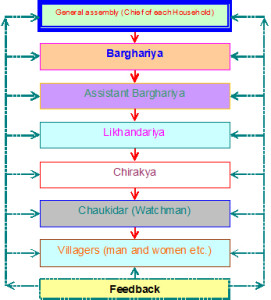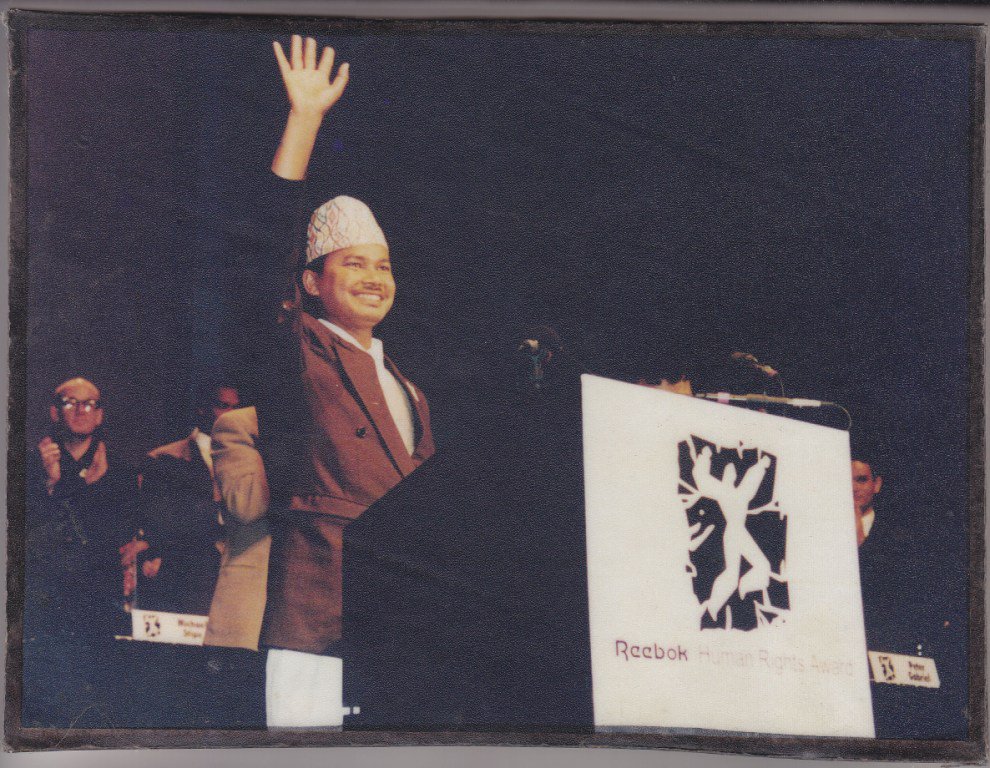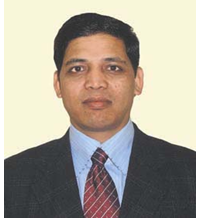Innovation
Traditional Network of Tharu
Introduction of Tharu Organizational system
In the world every indigenous and tribal group has own type of organizational system to regulate community works. Like the same the oldest indigenous community that is ”Tharus” have also very old, genuine and traditional organizational system.
Tharu organizational systems are constructed in order to regulate their main occupation, i.e., agriculture. Though, we have divided it into 4 groups to make it more specific and professional, namely, Barghariya organizational system, Kulapani Chaudhary organizational system, Family organizational system and Agro-farming organizational system.
Barghariya system is basically for village leadership and Kulapani Chaudhary system is for managing water to do irrigation paddy farms. Both organization systems are well established in the Tharu community. Family and agro-farming organizations are more inter-related to each other.
Before the Hill and Indian migration, the Tharu organizations were in wide practiced in all over Tarai and Inner Tarai. But right now, its effectiveness and practice both are gradually decreasing.
Defining Tharu Organizational system
Organization is managerial body that carries out every work systematically. And system is a procedure of carrying out the jobs in organized way. So, organizational system is a administrative and managerial body or structure that handles and completes the particular profession smoothly with good care. If we add “Tharu” as a pre-fix, the meaning will coincide to Tharu community. Here we are discussing about indigenous knowledge of Tharu regarding on organizational system, so the definition enrols from its origin to transformation to their subsequent generations. Tharu organization system is defined as follows –
”Tharu organizational system is directly inherent to Tharu community, which is derived from many years of experience and transforming from one generation to another. Under which each Tharu easily accepts and follows all the norms and values of it. It does not require written rules and regulations to enforce them to follow all the norms and values of Tharu organizational system”.
Tharu organizations developed by Tharus, adopted by Tharus, flourished by Tharus, strengthened by Tharus, systematized by Tharus and is still practicing by Tharus. So, these organizations are defined so long as to corresponding Tharu ownership. It means that Tharus have first right to lead such organizations. Tharu and non-Tharu all can be the member, who freely pursue all the norms and values of Tharu organizational systems. Rights and responsibilities of each hierarchical post are oral, not written but well defined, every member of Tharu community know and can describe about it. It proves that every Tharu organization has inherent relation with each member of Tharu community and even non-Tharu people who have been living in Tharu villages.
Types of organizational system in Tharu community
Baghariya Association has grouped Tharu organizational system based on their nature of works and its uses, but all are related with the main profession agriculture. Tharu organizations are classified as per bellow.
Chart No. 1: Classification of Tharu organizations
Chart No. 1 is showing that Tharu organizations are classified into 4 different groups, namely, Barghariya organizational system, Kulapani Chaudhary organizational system, Family organizational system and Agro-farming organizational system. Kulapani Chaudhary and Agriculture farming organizational system are directly related with the main profession of Tharu that is agriculture. Barghariya organizational system administers village leadership and Family organizational system facilitates household management. But some components of Barghariya organizational system also help to agriculture farming works.
Each organization has unique hierarchical posts and defined rights and responsibilities. The detailed of each organizational system is given bellow.
Barghariya system (BS)
Barghariya is village level organization. Under this system, Barghariya, assistant Barghariya, Likhandariya, Chirakya, watchman and villagers play their roles as define traditionally. Among of them, Barghariya is the topmost hierarchy, though general assembly of villagers is another body, which provides directions and mended. Barghariya is also called ”Kakandar” in Banke and Deukhuri; ”Mahatanwa” in Dang; ”Bhalmansa” in some parts of Kailali and Bardiya; Barghariya in Kanchanpur. Tharu Barghariya leads all the community works. All the villagers respect him/her and obey directives and suggestion ordain by Barghariya.
Under this organizational system, there is a village chief who is called “Barghariya” and other subordinate officials and villagers. They select or elect new Barghariya or renew tenure or term of previous one each year in the month of Magh (15 January to 15 February). Each household chief gathers in the yard of Barghariya and selects the new/previous Barghariya and other officials for one year by doing free and open discussion. After wards, they do other discussion and planning works. Around 10 years before, it was system to participate only male but now days women also take participation in general assembly and regular meetings of it.
Barghariya does many of the routine works and some new continental works. Before starting any of the works, at first, all the villagers gather, which is called “Khyala” in Dang-Deukhuri, “Jutelha” in Bardiya, Banke, Kanchanpur and Kailali districts. Barghariya and/or Assistant Barghariya conveys the subject matter to all and starts discussion and makes unanimous decision. After wards, they execute the decision previously made, If any one else did negligence or did not present, punishes in terms of cash or kind immediately.
3.2 Organizational Structure
Barghariya organizational structure has many hierarchical posts, each inter-relates with one-another. The organizational chart of Barghariya system is given bellow.
Chart No. 2: Organizational Structure of Barghariya System
The topmost and powerful body of this organization is General Assembly (Khyala), which takes place each year in the month of Magh (15 January to 15 February). It selects new Barghariya and other subordinate officials and gives mended. Executive topmost designation is Barghariya, who leads the Barghariya organizational system and implements the decision made by general assembly. Chart No. 2 is showing about the provision of assistant Barghariya. If particular village is big, then only the assistant Barghariya selects, the numbers of assistant Barghariya depends upon size of village. They help in the works of full Barghariya. Likhandariya keeps all the records and writes minutes. Chirakya lights the oil lamp of Deuthan (deity place) and welcomes bridge people lightening on the way. Watchmen watch the village and carry letters or information. The most important wing of this organization is collecting feedbacks from internal and external commenter through all of the hierarchies and takes corrective actions, if needed.
An organizational chart of this system is mostly similar in Dang-Deukhuri, Banke, Bardiya, Kailali, Kanchanpur and Surkhet.
The General Assembly selects Barghar Bhalmansa Mahtawa Kakandar, Chaukidar (Watchman) and also provides directives. Among of them, this post is the executive topmost designation, who leads the villagers. The duty of Chaukidar is to watching villagers, communicate information from one village to others or delivery of letters and do as per direction of Barghariya. Chaukidar also goes to local police office once in each week and gets monthly payment from related police office. As per need of villagers and over workload of Chaukidar.
Selection Procedure
Under Barghariya system, the tenure of each official is of 1 year. So, every year, they elect/select/nominate new or give continuity to previous officials within the first week of Maghi Diwani or within the month of Magh (which falls in between January 15 to February 15). In some exceptional cases, they also elect before or later than of Magh month. The general procedure of election is as follow.
- By taking the suggestion and consent of other officials and villagers, the Barghariya calls the meeting of General Assembly, which is called ”Khyala” in Dang and “Jutelha” in Bardiya, Kailali and Banke.
- On the particular date and time, all the villagers – 1 from each household gather in the Yard of Barghariya’s house. Basically it starts at morning time that around 8 o’clock.
- After gathering all, Barghariya starts the meeting and also puts their experience of last year.
- Then, other interested participants also put their views. At that time, they also review the works of previous Barghariya and its team members.
- The meeting goes on free and open discussion of all participants. During this meeting, every participant is free to say his or her views. So, it is very democratic exercise.
- First of all, they try to select or nominate Barghariya and other officials based on unanimous decision. But if not possible, they do election also.
- For the case of election, candidates announce him or her for particular post. All the participants vote them. The voting system depends upon availability of facilities or materials.
- Lastly who gets more vote – is elected in the particular post.
- After wards, they prepare yearly planning; and celebrates feast evening time.
Thus the basic election procedures of Barghariya system have completes.
3.4. Rights and duties of Barghariya and other sub-ordinates
The basic rights and duties of Barghariya in Dang, Banke, Bardiya, Kailali, Kanchanpur, Surkhet and Rupandehi are similar, which are given bellow in Chart No.3
Chart No. 3: Rights and duties of Barghariya and other sub-ordinates
Chart No. 3 is describing that Barghariya has mainly 6 functions. These are leadership role, judicial role, planning and development role, ritual role, administrative role and unity role. He performs all these roles by taking help of their subordinates and villagers. Under leadership role, s/he plays the role of village leader and some times modern leadership, means becomes elected representative of VDC. S/he, under judicial role, solves the disputes at village level, tradition of solving most of all cases at village level, this is the prestigious subject for Tharu community. For the purpose of planning and development, they prepare plans to make culverts, bridges, link roads, school buildings, irrigation cannel and dams, etc. They also make plan for the selection of Deshbandhya and Kesauka Guruwa, Chirakya and Chaukidar. Few years ago, there was system to appoint blacksmith and tailor for all villagers. So, it was also system to select them. For the construction work, the first priority gets internal sources. If that resource becomes insufficient, they look other resources from VDC, DDC as well as NGO supports. Barghariya plays crucial role to mobilize labour contribution but now days it is becoming less effective because of Hill and Indian migration. Most of the Pahadi and Madhesi people denies for labour and cash contribution and even Barghariya leadership. This system break is affecting to Tharu people also.
Another most important role of Barghariya is to perform ritual works. Under this system, they lead on the selection of Deshbandhya Guruwa, Kesauka Guruwa, Chirakya and conduction of common worships, like, Hareri Puja, Dhuriya Puja, Lawangi Puja, Bhajahar Puja, etc. They also manage and facilitate for doing folk dances, festivals and marriage ceremonies.
Unity is the ornament of Tharu society. On the leadership of Barghariya, all the villagers have always same voice; they do all the works jointly by doing unanimous decision. But now days, this unity is gradually decreasing day to day because of diving role of different political parties and mixed community, Hill and Indian migration. This is the big challenge of existence of Tharu Barghariya organization system.
Last but not least that is administrative role, s/he appoints supporting staffs and provides ToR as per the post of them. It means that s/he plays the role of executive, directorial and managerial. A successful Barghariya always leads to all, provides feeling of good governance and gets good respect from the all the members of their community.
But most of all roles and responsibilities and social respect of Barghariya, at present, is gradually becoming threatened. Such threatens are coming from elected ward chairs and members, Hill and Indian migrated peoples, diving roles of different political parties, negligence role of government offices, diversification of profession, effect of town and globalization and young groups.
Under the Barghariya system, there are other sub-ordinate posts, like, assistant Barghariya, Chirakya, Chaukidar, etc. Among of them, assistant Barghariya assist to full Barghariya. Chirakya regularly lightens the oil lamp at common deity place, during marriage ceremony and at the time of worshiping. Chaukidar or watchman watches the villages, carries letters and/or information from one village to another and do as a peon of Barghariya.
International Labor Organization (ILO) 169
As per the above mentioned system and introduction. The Barghariya system is the one of the ruling and governing system of Tharus. Since the ancient period this system has been ruling Tharus and governing Tharus. This system has been playing developmental, Judiciaries and safety and security among the Tharus.
Since the new system and structure of the government of Nepal and political structure of Nepal, the oldest system of Thaurs have been badly affected. The new government’s structure and system dose not reorganized this traditional system and neglected. But this have been active and playing the same kind of role in Tharu people. In this way the Tharus governing system is excluded and Tharus have are deprived from development and decision making bodies.
Is the Tharus Barghar system once reorganized by the government and included in the government structure Tharus will be included in the mainstream and the development will be more inclusive.
So, it is needed to strengthened and reorganized and included by the government. The planning’s done by Barghariyas should be included in the VDC assembly and should be included in the VDC planning’s. The development budget should go through this system to develop the community and real participation of deprived people can be increased.





